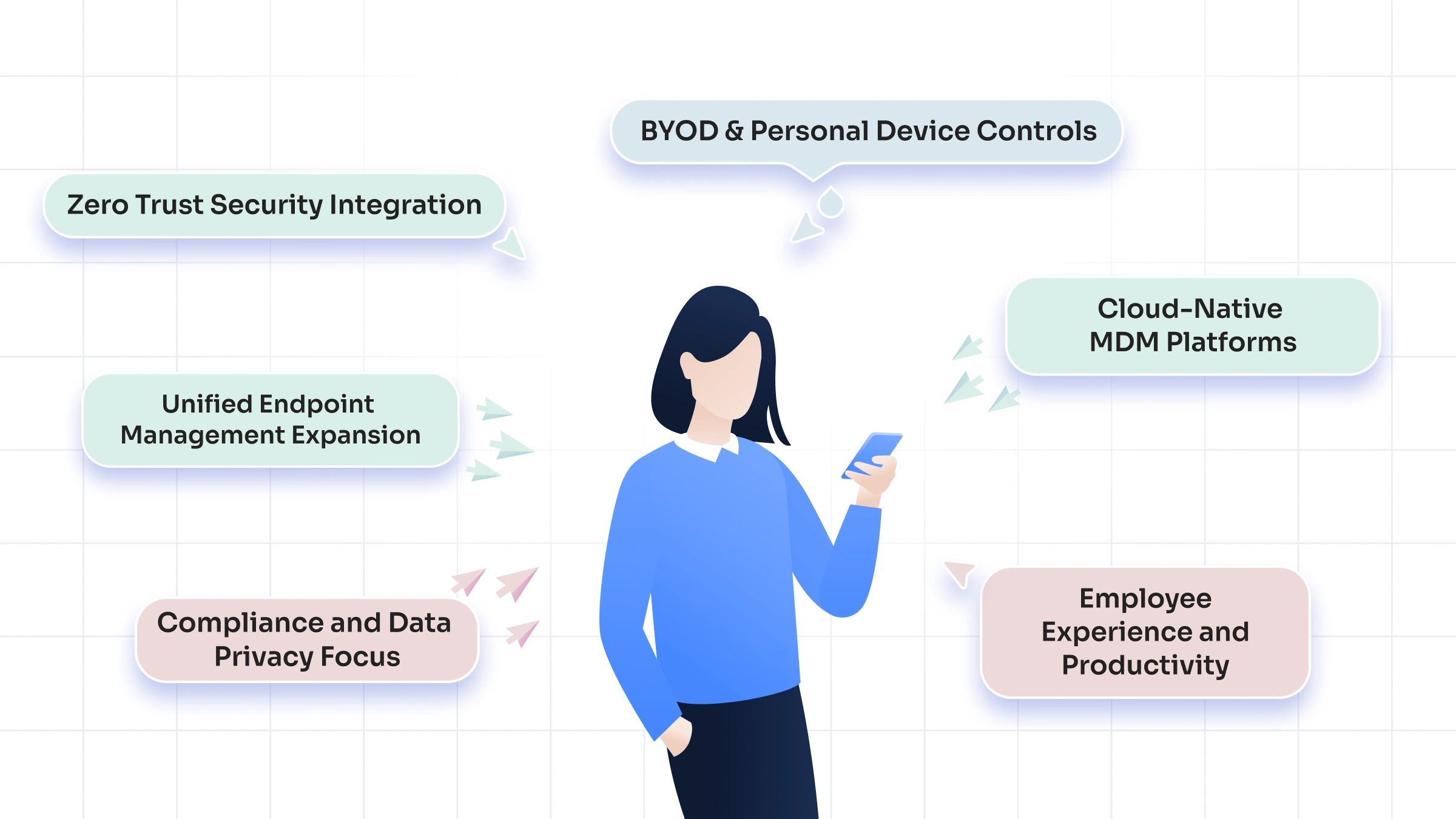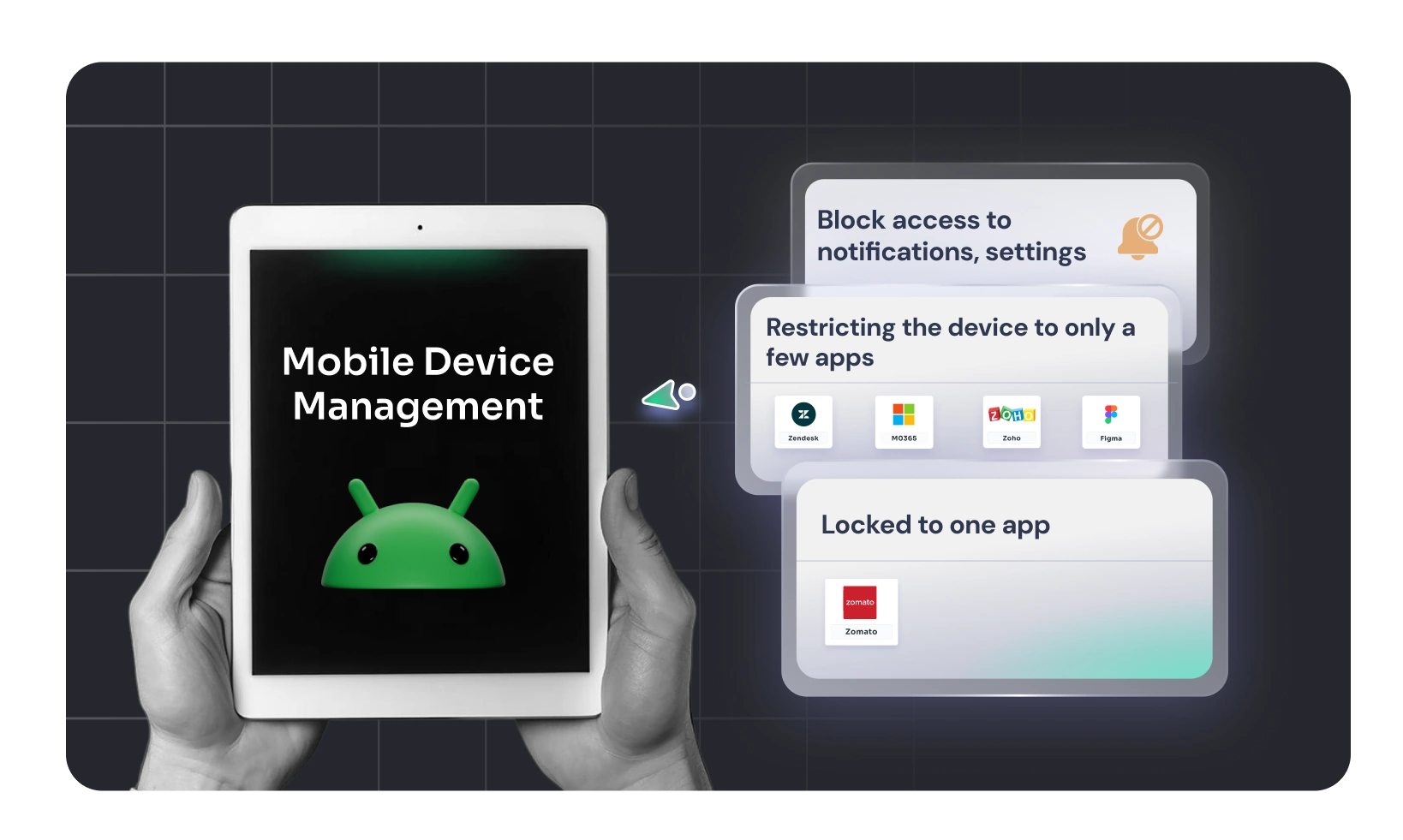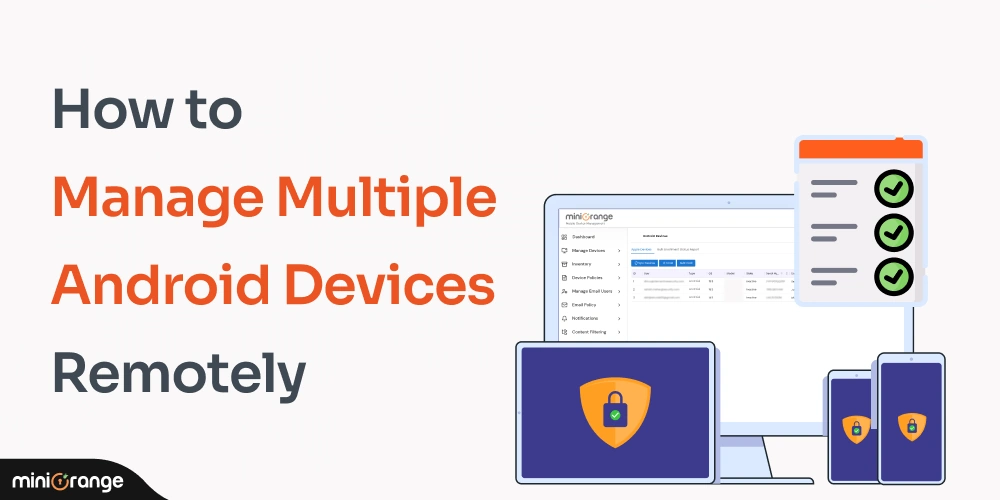Latest Trends in Mobile Device Management in 2025
Five years ago, managing mobile devices mostly meant tracking phones and enforcing passcodes. Fast forward to 2025, and the stakes couldn’t be higher. With 74% of companies supporting hybrid or fully remote workforces (McKinsey), mobile devices have become the primary gateway to business data, and a prime target for attackers.
The answer lies in staying ahead of the latest mobile device management trends. In this article, we’ll explore the top MDM trends in 2025, what they mean for your organization, and how adapting early will help you stay competitive and compliant.
Top 6 Mobile Device Management (MDM) Trends You Need to Know

1. Zero Trust Security Integration
Traditional perimeter-based security is no longer enough. Zero Trust assumes no device or user should be trusted by default — every access request must be verified continuously.
- Gartner predicts that by 2025, 60% of organizations will adopt Zero Trust as a foundation for MDM strategies.
- In practice, this means integrating multi-factor authentication (MFA), device health checks, and contextual access controls into your MDM solution.
If you’re not already aligning your policies with Zero Trust, now’s the time. It’s quickly becoming the baseline expectation in enterprise security.
2. Stronger BYOD and Personal Device Controls
According to BusinessWire, 65% of devices accessing business data are personally owned. This trend won’t slow down anytime soon. The challenge? Balancing security with employee privacy. The latest MDM strategies use:
- Containerization to separate business apps and personal data.
- Policy-based access that only secures corporate files, leaving personal photos, messages, and apps untouched.
- Remote wipe for corporate data only, not the entire device.
This approach reassures employees while giving IT confidence that sensitive data is protected.
3. Cloud-Native MDM Platforms
The shift to cloud-native solutions is reshaping the mobile device management market. IT teams no longer want bulky, on-premise setups; they need scalability, agility, and lower costs.
- The global MDM market is projected to hit $33.7 billion by 2030 (MarketsandMarkets).
- Cloud-native platforms let admins manage devices from anywhere, an essential capability for hybrid and global teams.
The takeaway: if your current MDM is tied to a local server, consider upgrading to cloud-native before you get left behind.
4. Unified Endpoint Management (UEM) Expansion
MDM is converging with Unified Endpoint Management (UEM) solutions that cover not just smartphones and tablets but also laptops, IoT devices, and wearables.
Why it matters:
- One dashboard for all devices reduces IT complexity.
- Policies are applied consistently across every endpoint.
- It saves time and reduces misconfigurations.
Think of it like upgrading from managing multiple toolkits to using one all-in-one Swiss Army knife.
5. Compliance and Data Privacy Focus
Global regulations are evolving fast, GDPR in Europe, HIPAA in healthcare, CCPA in California, and new regional data laws popping up every year.
The future of mobile device management includes compliance baked in, with features like:
- Automated reporting for audits.
- Data loss prevention (DLP) tools to stop sensitive file sharing.
- Geo-fencing policies to restrict data access outside certain regions.
Ignoring compliance can mean massive fines and reputational damage. A strong MDM solution helps you stay compliant and future-ready.
6. Employee Experience and Productivity
Security can’t come at the cost of productivity. Employees need frictionless access to work apps, whether on a company-issued laptop or a personal tablet.
Latest MDM trends focus on:
- Single Sign-On (SSO) for one-click access.
- Automated updates to reduce downtime.
- File/content sharing or notification broadcasting to ensure employees receive business information instantly and can share work files across devices.
Powerful MDM with miniOrange
Staying on top of these latest MDM trends can feel overwhelming — unless you have the right solution. This is where miniOrange MDM shines.
Here’s how miniOrange supports the future of mobile device management:
- Zero Trust Security: built-in MFA, device health checks, and adaptive access policies.
- BYOD Security: secure containerization and selective wipe for personal devices.
- Cloud-Native Architecture: manage devices anytime, anywhere, with no costly hardware.
- Unified Endpoint Management (UEM): one console for mobiles, desktops, rugged devices, and more.
- Compliance-Ready Tools: automated audit reports, DLP, and geo-fencing support.
- Employee Experience Enhancements: Single Sign-On (SSO) to simplify user logins.
With miniOrange, you don’t just keep up with MDM market trends, you stay ahead of them.
Conclusion
The mobile device management trends of 2025 show that the field is moving beyond simple device control to become a central pillar of enterprise security and productivity. From Zero Trust adoption to AI-driven monitoring and cloud-native platforms, the future of mobile device management will be smarter, more secure, and user-focused.
The good news? You don’t need multiple tools or a large IT staff to keep up. The miniOrange MDM solution brings everything together in one platform — securing devices, protecting data, and empowering your workforce.
Frequently Asked Questions
1. What is the future of mobile device management (MDM)?
The future of MDM is moving beyond simple device control to include Zero Trust security, unified endpoint management, AI-driven monitoring, and cloud-native platforms. These trends make MDM more central to enterprise security and employee productivity.
2. Why is Zero Trust a key MDM trend in 2025?
Zero Trust is becoming an emerging trend in 2025 because cyberattacks are growing more advanced. By continuously verifying devices, users, and context, MDM solutions with Zero Trust reduce risks of credential theft, compromised devices, and unauthorized data access.
3. How does BYOD impact MDM trends in 2025?
With more than 65% of employees using personal devices for work, BYOD is driving new MDM strategies. MDM solution focuses on containerization, selective data wipe, and privacy-first policies to balance employee flexibility with enterprise security.
4. Which MDM solution aligns with the latest trends in 2025?
Solutions like miniOrange MDM are designed with future trends in mind, offering Zero Trust policies, BYOD support, compliance tools, and unified endpoint management — all from a cloud-native platform.
contact us at uemsupport@xecurity.com to grab a customized solution for your unique business use case.






Leave a Comment